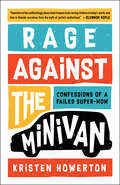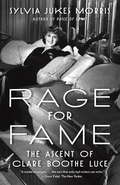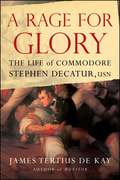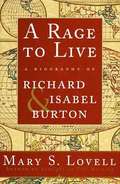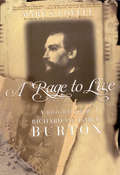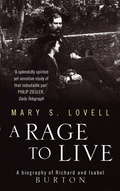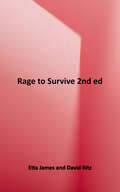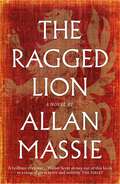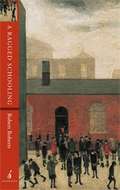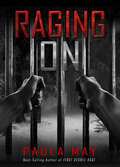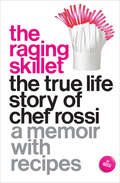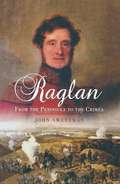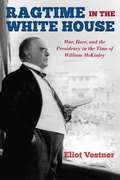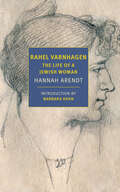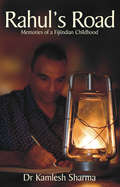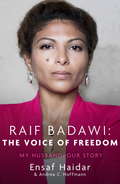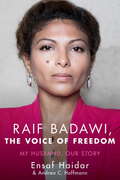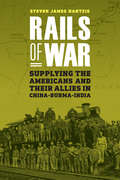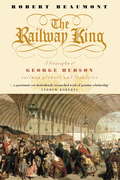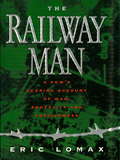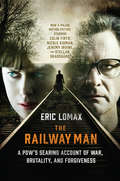- Table View
- List View
Rage Against the Minivan: Learning to Parent Without Perfection
by Kristen Howerton&“With humor, vulnerability, and heart, Kristen Howerton writes unflinchingly about what it means to be raising children in today&’s world and how to liberate ourselves from the myth of perfect motherhood.&”—Glennon Doyle, author of Untamed and Love Warrior, founder of Together RisingIn Rage Against the Minivan, blogger, podcaster, and licensed marriage and family therapist Kristen Howerton lends solidarity to those who love their kids like crazy but feel like parenting is making them crazy, too. With her signature blend of vulnerability, sarcasm, and insight, Howerton shares her unexpected journey from infertility to adoption to pregnancy to divorce to dealing with the shock and awe of raising teens.This book is for• the parent who had it totally figured out before they had kids• the parent who said &“I will never . . .&” and now they have• the parent who needs a time-out and a nap as badly as their child does• the parent who looks like they have it all together but feels like a hot mess on the inside• the parent who looks like a hot mess on the outside, too• the parent who asks Am I good enough? Doing enough? Doing it right? What&’s wrong with me? What&’s wrong with these children? Are they eighteen yet?Recounting her successes, trials, mishaps, and hard-won wisdom as a parent of four kids—both white and black—Howerton tackles many of the thorny issues parents face today, like hard conversations about racism, disciplining other people&’s kids, the reality of Dad Privilege, and (never) attaining that elusive work/life balance. Whether it&’s about toddler tantrums or teen angst, Howerton reveals how she learned to opt out from the pressure to do it all perfectly and opt in to excelling at average. Poignant and relatable, Rage Against the Minivan is a permission slip to allow yourself to be a &“good enough&” parent, learning how to love your kids well while letting yourself off the hook.
Rage for Fame
by Sylvia MorrisDetailed and rich with mesmerizing narrative, Rage for Fame recounts the story of the flowering years of Clare Booth Luce--a former congresswoman and editor of Vanity Fair--a striking woman whose private life was as intriguing and spectacular as her public life. 45 photos.From the Hardcover edition.
A Rage for Glory
by James Tertius de KayStephen Decatur was one of the most awe-inspiring officers of the entire Age of Fighting Sail. A real-life American naval hero in the early nineteenth century, he led an astonishing life, and his remarkable acts of courage in combat made him one of the most celebrated figures of his era. Decatur's dazzling exploits in the Barbary Wars propelled him to national prominence at the age of twenty-five. His dramatic capture of HMSMacedonianin the War of 1812, and his subsequent naval and diplomatic triumphs ...
A Rage to Do Better: Listening to Young People from the Foster Care System
by Nell BernsteinAsk a teenager why she ran away from a group home and you will hear one thing over and over: They didn't believe me. Nearly every foster care fugitive---and many who stayed--has a story of the moment they realized their words didn't matter, that their account of their life would never be definitive. Ask what might have made the difference, what might have made them stay, and they will tell you, "If somebody had listened...."
A Rage to Live: A Biography of Richard and Isabel Burton
by Mary S. LovellBiography of the famous explorer, Sir Richard Francis Burton, 1821-1890, and his wife Isabel.
A Rage to Live: A Biography of Richard and Isabel Burton
by Mary S. LovellAn "extraordinary biography" (New York Times Book Review) of a brilliant pair of adventurers. Their marriage was both improbable and inevitable. Isabel Arundell was a schoolgirl, the scion of England's most distinguished Catholic family. When she first saw him while walking at a seaside resort, Richard Burton had already made his mark as a linguist (he was fluent in twenty-nine languages), scholar, soldier, and explorer--at once a symbol of Victorian England's vision of empire and an avowed rebel against its mores. When she turned and saw him staring after her, she decided that she would marry him. By their next meeting, Burton had become the first infidel to infiltrate Mecca as one of the faithful, and, in an expedition to discover the source of the Nile, would soon be the first white man to see Lake Tanganyika. After being married, the Burtons traveled and experienced the world, from diplomatic postings in Brazil and Africa to hair-raising adventures in the Syrian desert. In later life Richard courted further controversy as a self-proclaimed erotologist and the translator of The Kama Sutra. Based on previously unavailable archives, Mary Lovell has written a compelling joint biography that sets Isabel in her proper place as Burton's equal in daring and endurance, a fascinating figure in her own right.
A Rage To Live: A Biography of Richard and Isabel Burton
by Mary S. LovellRichard Burton was a brilliant, charismatic man - a unique blend of erudite scholar and daring adventurer. Fluent in twenty-nine languages, he found it easy to pass himself off as a native, thereby gaining unique insight into societies otherwise closed to Western scrutiny. He followed service as an intelligence officer in India by a daring penetration of the sacred Islamic cities of Mecca and Medina disguised as a pilgrim. He was the first European to enter the forbidden African city of Harar, and discovered Lake Tanganyika in his search for the source of the Nile. His fascination with, and research into, the intimate customs of ethnic races (which would eventually culminate in his brilliant Kama Sutra) earned him a racy reputation in that age of sexual repression.Little surprise, then, that Isabel Arundell's aristocratic mother objected to her daughter's marriage to this most notorious of figures. Isabel, however, was a spirited, independent-minded woman and was also deeply, passionately in love with Richard. Against all expectations but their own, the Burtons enjoyed a remarkably successful marriage.
Rage to Survive: The Etta James Story
by Etta James David RitzPerhaps the finest soul singer of the rock era - equally at home singing blues and jazz -- Etta James is one of the great women of American music. In Rage to Survive she tells her mesmerizing tale in her uniquely big, bold, and unrepentant voice. Without a trace of self-pity, she describes her chaotic world of early R&B, depicts legends like Sam Cooke and Little Richard, details her dependency on drugs and bad men, and unsparingly recounts the golden age of soul, when her "Tell Mama" topped the charts. Rage to Survive is a funky, ribald tale told with unparalleled sass.
The Ragged Lion: A Novel
by Allan MassieFrom the author of Caesar and The Sins of the Father, a fictional memoir of the celebrated Scottish Romantic writer and historical novelist. Allan Massie recreates the life and times of Sir Walter Scott, one of Scotland&’s greatest writers, convincingly capturing Scott&’s humor, stoicism and eccentricity. Combining imaginative plausibility with his own deep knowledge of and love for Scott&’s work, Massie reveals the intimate thoughts of a man at odds with his popular image: good and courageous, but also an enigma to those around him. By turns a ghost story and an examination of the Scottish character, The Ragged Lion is utterly enthralling.Praise for The Ragged Lion&“Massie captures Scott&’s humor, and his tragic qualities and stoicism.&” —The Evening Standard (UK)&“Profoundly human . . . Massie is a novelist for grown-ups.&” —The Spectator (UK)
A Ragged Schooling: Growing Up in the Classic Slum
by Robert RobertsAn English working-class autobiography told by Robert Roberts who was born in Salford, England near Manchester in 1905. With great humour and vitality, he evokes his Edwardian childhood in this vivid portrait of a vanished community. Breathing the smoke from factory chimneys, the children of Salford struggled daily to survive the grinding poverty that surrounded them. Sharing lively games along the railway lines and canal banks, their lives were rich in experience and comradeship. Some had parents who strove for a better life but others were much less fortunate. Robert was fourth of a family of seven, left school at fourteen and served time as an engineering apprentice before retraining as a teacher. He taught illiterate prisoners in Strangeways, describing the experience in his first book, Imprisoned Tongues. In recognition of his work in adult literacy, he received an honorary MA from the University of Salford. He died in 1974, leaving A Ragged Schooling as his legacy. Originally published 1976.
Raging On (The "Rage" True Crime Series)
by Paula MayThe author of First Degree Rage continues the ongoing true crime saga of obsessive jealousy, murder, and revenge in North Carolina. Police Officer L. C. Underwood terrorized his ex-fiancé Kay Weden and her son Jason. Though he evaded justice for a time, Detective Paula May uncovered the truth and saw him convicted for murdering Kay&’s boyfriend, Viktor Gunnarsson. But was Underwood also responsible for the brutal murder of Kay&’s mother, Catherine Miller? Now, despite being sentenced to life in prison plus forty years, Underwood vows to exact revenge on everyone he deems responsible for his arrest. He rages on, plotting his next move, enlisting others to wreak havoc in the lives of Kay, Jason, Detective May, and others. Will they ever find peace? Will Catherine Miller&’s murder ever be solved? Will Underwood&’s reign of terror ever be stopped?
The Raging Skillet: The True Life Story of Chef Rossi
by RossiWhen their high-school-aged, punk, runaway daughter is found hosting a Jersey Shore hotel party, Rossi's parents feel they have no other choice: they ship her off to live with a Chasidic rabbi in Crown Heights, Brooklyn. Within the confines of this restrictive culture, Rossi's big city dreams take root. Once she makes her way to Manhattan, Rossi's passion for cooking, which first began as a revolt against the microwave, becomes her life mission. The Raging Skillet is one woman's story of cooking her way through some of the most unlikely kitchens in New York City--at a "beach" in Tribeca, an East Village supper club, and a makeshift grill at ground zero in the days immediately following 9/11. Forever writing her own rules, Rossi ends up becoming the owner of one of the most sought-after catering companies in the city. This heartfelt, gritty, and hilarious memoir shows us how the creativity of the kitchen allows us to give a nod to where we come from, while simultaneously expressing everything that we are. Includes unpretentious recipes for real people everywhere. Rossi is the owner and executive chef of The Raging Skillet, described as a "rebel anti-caterer" by the New York Times. Rossi has written for many publications, including Bust, the Daily News, the New York Post, the Huffington Post, Time Out New York, and McSweeney's. She is the host of a long-running radio show in Cape Cod, Massachusetts.
Raglan: From the Peninsula to the Crimea
by John SweetmanAll too many historians have dismissed FitzRoy James Henry Somerset, first Baron Raglan, as at best, an indifferent and, at worst, an incompetent on the basis of his association with the infamous Charge of the Light Brigade.Yet as this long overdue biography of a pivotal military figure of the 19th Century reveals Raglans achievements over fifty years should not be judged on so narrow a basis. True, as Commander of the Expeditionary Force to the Crimea, he must take his share of responsibility for the hardship suffered by the men under him particularly during the winter of 1854-55 but the fact remains that Raglan never lost a battle for which he was fully responsible.Commissioned in 1804 he served under Sir Arthur Paget and the Duke of Wellington, throughout the Peninsular War losing an arm at Waterloo. He held key posts, including Military Secretary for an astonishing 25 years and Master General of the Ordnance and his influence was far reaching.Raglan is revealed in this objective study as a brave, thoughtful, caring and capable man, who found himself an easy target for critics of an outdated and inadequate military administrative system. Very personal attacks, some from official quarters, mortally wounded him and he died in June 1855, a mere seven months after being appointed a field marshal amid public acclaim.In this first full biography of Raglan, John Sweetman examines not just the man himself but the workings of an Army that was straggling to keep up with social and technological change. Readers will find this a fine expos of a man who was placed in a no-win situation through little fault of his own.John Sweetman graduated from Brasenose College Oxford (Modern History) before taking a PhD at Kings College, London. He later became Head of Defence and International Affairs at RMA Sandhurst. He is the author of numerous military works. Now retired he lives at Camberley.
The Ragman's Son: An Autobiography
by Kirk DouglasRaised in poverty, longing for his father's approval, Issur Danielovitch went on to become a legendary Hollywood star - Kirk Douglas. Here in his own words is the story of his life.
Ragtime in the White House: War, Race, and the Presidency in the Time of William McKinley
by Eliot VestnerHistory played a trick on McKinley. He has been consigned to the shadows between Lincoln and Theodore Roosevelt, vilified or ignored by historians . . . It is a richly undeserved fate.As Eliot Vestner demonstrates in this narrative of the political life of William McKinley, there was much more to the twenty-fifth president&’s tenure in office than history books allow. He was a popular president, winning a second term with ease. But only nine months into it, he was assassinated by a self-described anarchist. What more he might have accomplished is anyone&’s guess. He had managed to successfully pull America out of one of the worst economic depressions yet experienced, the Panic of 1893. And his controversial tariffs strengthened industry and contributed to the overall wealth of the country, as did his return of the country to the gold standard. He also led the U.S. to victory in the Spanish-American war, and implemented the first steps toward building the Panama Canal, which his successor, Theodore Roosevelt, continued. Perhaps the most under-appreciated aspect of McKinley&’s presidency was his advocacy for black civil rights, and his challenge to the white supremacy of the south. As governor of Ohio, he fought against lynching. He signed a ground-breaking anti-lynching bill. Ironically, as president, he had a much more difficult time combating violence and racial injustice because of the use of states&’ rights as justification for voter suppression and terrorism towards blacks. He pursued opportunities to advance the interests of black Americans wherever he could, but his inability to stop the lynchings and disfranchisement of blacks was most regrettable. His successors had no interest in the race issue, which remained unresolved until the 1954 court decision in Brown v. The Board of Education. This book gives McKinley his due, and thereby helps us better understand a President of the United States whose work has seemingly been overlooked by most Americans today.
Rahel Varnhagen: The Life of a Jewish Woman
by Hannah ArendtA biography of a Jewish woman, a writer who hosted a literary and political salon in late eighteenth- and early nineteenth-century Germany, written by one of the twentieth century's most prominent intellectuals, Hannah Arendt.Rahel Varnhagen: The Life of a Jewish Woman was Hannah Arendt&’s first book, largely completed when she went into exile from Germany in 1933, though not published until the 1950s. It is the biography of a remarkable, complicated, passionate woman, and an important figure in German romanticism. Rahel Varnhagen also bore the burdens of being an unusual woman in a man&’s world and an assimilated Jew in Germany.She was, Arendt writes, &“neither beautiful nor attractive . . . and possessed no talents with which to employ her extraordinary intelligence and passionate originality.&” Arendt sets out to tell the story of Rahel&’s life as Rahel might have told it and, in doing so, to reveal the way in which assimilation defined one person&’s destiny. On her deathbed Rahel is reported to have said, &“The thing which all my life seemed to me the greatest shame, which was the misery and misfortune of my life—having been born a Jewess—this I should on no account now wish to have missed.&” Only because she had remained both a Jew and a pariah, Arendt observes, &“did she find a place in the history of European humanity.&”
Rahel Varnhagen: The Life of a Jewish Woman
by Hannah Arendt Clara Winston Richard WinstonRahel Varnhagen (1777-1833) lived during the crucial period of assimilation in Germany, when it seemed imperative for Jews to escape their Jewishness.
Rahul’s Road: Memories of a Fijiindian Childhood
by Dr Kamlesh SharmaRahul's Road is a story of childhood in a Fijiindian village, Korovuto in Nadi on the largest island of the Fijian archipelago in the South Pacific. It presents a rich tapestry of the details of what it was like to grow up in a poor Fijiindian family. It captures moments of growing-up in Fiji with vividness and sensitivity. Written with feeling, the author's language has a simplicity that is quite remarkable in its richness and associations. The story told is complex, moving and vividly narrated. Rahul's Road will echo in the mind and memory of many Fijiindians within and outside their place of birth. It is a book for children, adolescents, adults who care about Fiji and the struggles and strengths of a migrant community. It cuts across barriers and builds bridges of memory, remembrance and understanding.
Raif Badawi: My Husband, Our Story
by Ensaf Haidar Andrea C HoffmannThe whole world knows the face of the young man with the bright black eyes. He is in the process of becoming an icon, a symbol, similar to the famous photo of Che Guevara. The face is that of Raif Badawi, who was nominated for the 2015 Nobel Peace Prize. Arrested in Saudi Arabia, he was sentenced to ten years' imprisonment and 1000 lashes - a de facto death sentence.The woman who succeeded in getting such people as Barack Obama and Prince Charles to appeal personally to the Saudi King for Badawi's release is his wife, Ensaf Haidar, who began the campaign to free her husband with a self-painted poster in front of a small church in Sherbrooke, Canada.When Raif Badawi and Ensaf Haidar fell in love with each other as adolescents, they did so in violation of every moral precept in the strictly Islamic Kingdom of Saudi Arabia. During their clandestine love affair, the young couple had no idea that, more than a decade later, Ensaf's love for Raif would attract the attention of politicians from around the world as the blogger's wife now mobilises global public opinion in an effort to save her husband from murder at the hands of the Saudi judiciary. With a courage born of desperation, she is fighting from exile in Canada to secure the release of the father of her three children, and is bringing great pressure to bear on the murderous regime in her native country.Ensaf Haidar tells Raif's and her own story: the story of their shared liberal ideas and her fight for her husband's release.
Raif Badawi: My Husband, Our Story
by Ensaf Haidar Andrea C HoffmannThe whole world knows the face of the young man with the bright black eyes. He is in the process of becoming an icon, a symbol, similar to the famous photo of Che Guevara. The face is that of Raif Badawi, who was nominated for the 2015 Nobel Peace Prize. Arrested in Saudi Arabia, he was sentenced to ten years' imprisonment and 1000 lashes - a de facto death sentence.The woman who succeeded in getting such people as Barack Obama and Prince Charles to appeal personally to the Saudi King for Badawi's release is his wife, Ensaf Haidar, who began the campaign to free her husband with a self-painted poster in front of a small church in Sherbrooke, Canada.When Raif Badawi and Ensaf Haidar fell in love with each other as adolescents, they did so in violation of every moral precept in the strictly Islamic Kingdom of Saudi Arabia. During their clandestine love affair, the young couple had no idea that, more than a decade later, Ensaf's love for Raif would attract the attention of politicians from around the world as the blogger's wife now mobilises global public opinion in an effort to save her husband from murder at the hands of the Saudi judiciary. With a courage born of desperation, she is fighting from exile in Canada to secure the release of the father of her three children, and is bringing great pressure to bear on the murderous regime in her native country.Ensaf Haidar tells Raif's and her own story: the story of their shared liberal ideas and her fight for her husband's release.
Raif Badawi, The Voice of Freedom: My Husband, Our Story
by Ensaf Haidar Andrea Claudia HoffmannA powerful first-person account of Ensaf Haidar's life wither her husband, Saudi Arabian social activist Raif Badawi, and her worldwide campaign to free him from imprisonment Ensaf Haidar's unforgettable account of her marriage to imprisoned Saudi blogger Raif Badawi tells the story of the survival of their love against all odds, and of her courageous fight for her husband's freedom.When Ensaf and Raif married in 2002 they shed tears of joy; they had overcome the resistance of her family and the rigid conventions of Saudi Arabian culture, and their battle to be together was finally won. But an even greater challenge lay ahead. After the romance of their clandestine courtship, the triumph of their wedding day, and the ups and downs of married life, Ensaf discovers that Raif is becoming active in the liberal movement. Their partnership grows stronger as Raif works tirelessly, daring to question the social order of Saudi Arabia -- until his activities attract the attention of the religious police. With Raif under increasing surveillance, Ensaf reluctantly accepts exile as the only way to protect their three young children, hoping that Raif will soon join them.But Raif's arrest and subsequent sentence -- to ten years in prison and 1,000 lashes -- change everything. Ensaf must take up the fight for her husband's life, galvanizing global support and campaigning for his freedom -- and their right to be reunited as a family again. This profoundly moving memoir is both a love story and an inspiring account of the making of not one but two heroic human rights activists.
Rails of War: Supplying the Americans and Their Allies in China-Burma-India
by Steven James HantzisIn a theater of war long forgotten and barely even known at the time, James Harry Hantzis and his fellow soldiers labored at a thankless task under oppressive conditions. Nonetheless, as Rails of War demonstrates, without the men of the 721st Railway Operating Battalion, the Allied forces would have been defeated in the China-Burma-India conflict in World War II. Steven James Hantzis’s father served alongside other GI railroaders in overcoming danger, disease, fire, and monsoons to move the weight of war in the China-Burma-India theater. Torn from their predictable working-class lives, the men of the 721st journeyed fifteen thousand miles to Bengal, India, to do the impossible: build, maintain, and manage seven hundred miles of track through the most inhospitable environment imaginable. From the harrowing adventures of the Flying Tigers and Merrill’s Marauders to detailed descriptions of grueling jungle operations and the Siege of Myitkyina, this is the remarkable story of the extraordinary men of the 721st, who moved an entire army to win the war. For more information about Rails of War, visit railsofwar.com.
The Railway King
by Robert BeaumontGeorge Hudson - the eponymous Railway King - started his career with a stroke of luck, inheriting £27,000 (a fortune in 1827) from a distant relative. He invested successfully in the North Midland Railway, then formed his own Midland Railway, raising £5 million and bribing MPs along the way. But from his glory in 1845 he fell into disgrace, admitting corruption and selling land he did not own. He was eventually imprisoned in York Castle and died a broken man in 1871. His story provides an excellent insight into nineteenth-century politics and industrial progress, full of moral dilemmas and a testimony to the growth of the railways in Britain - a timely subject.
Railway Man: A POW's Searing Account of War, Brutality and Forgiveness
by Eric LomaxHere is a remarkable true story of forgiveness--a tremendous testament to the courage that propels one toward remembrance, and finally, peace with the past. A classic war autobiography, The Railway Man is a powerful tale of survival and of the human capacity to understand even those who have done us unthinkable harm. From The Railway Man: The passion for trains and railroads is, I have been told, incurable. I have also learned that there is no cure for torture. These two afflictions have been intimately linked in the course of my life, and yet through some chance combination of luck and grace I have survived them both. I was born in Edinburgh, in the lowlands of Scotland, in 1919. My father was an official in the General Post Office there, a career which he had started as a boy of 16 and which he intended me to imitate to the letter. He was fascinated by telephony and telegraphy, and I grew up in a world in which tinkering and inventing and making were honoured past-times. I vividly remember the first time that my father placed a giant set of headphones around my ears and I heard, through the hiss and buzz of far-off-energies, a disembodied human voice. In the worst times, much later, when I thought I was about to die in pain and shock at the hands of men who could not imagine anything of my life, who had no respect for who I was or my history, I might have wished that my father had had a different passion. But in the 1920s, technology was still powerful and beautiful without being menacing. Who would have thought that a radio, for example, could cause terrible harm? It seemed to be a wonderful instrument by which people could speak to each other; and yet I heard Hitler ranting over airwaves, and saw two men beaten to death for their part in making such an instrument, and suffered for my own part in it for a half a century.
The Railway Man: A POW's Searing Account of War, Brutality and Forgiveness
by Eric LomaxNow a Major Motion Picture Starring Colin Firth and Nicole Kidman. The Railway Man is a remarkable memoir of forgiveness--a tremendous testament to the courage that propels one toward remembrance, and finally, peace with the past. Eric Lomax, sent to Malaya in World War II, was taken prisoner by the Japanese and put to punishing work on the notorious Burma-Siam railway. After the radio he illicitly helped to build in order to follow war news was discovered, he was subjected to two years of starvation and torture. He would never forget the interpreter at these brutal sessions. Fifty years after returning home from the war, marrying, and gaining the strength from his wife Patti to fight his demons, he learned the interpreter was alive. Through letters and meeting with his former torturer, Lomax bravely moved beyond bitterness drawing on an extraordinary will to extend forgiveness.
